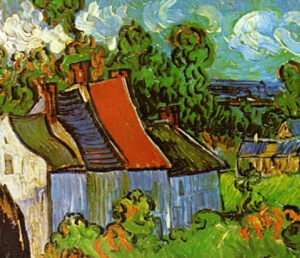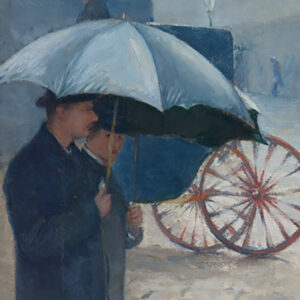“Thrift is the really romantic thing.”
—G.K. Chesterton




Dear Reader,
The other night someone was attempting to break into the front door of my house. The suspect was a caucasian male of average height and build, wearing a dark gray jacket. He was accompanied by a group of children. There is an artist’s rendering of him below. (Yes, it was me.)
Why was I trying to break into my own house? I was locked out. Why was I locked out? Because of the consumer economy.
If the above statement doesn’t quite resonate, bear with me; we’ll get to it. In the meantime, this statement will: there is a lot of inflation going on right now. These two statements are intertwined because a consumer economy lends itself to inflation. This is proving itself out. In fact, it is proving itself even more severely than we are being told.
One of the primary statistics of interest in a consumer economy is the CPI — Consumer Price Index. The CPI is up more than eight percent, year over year — so the government tells me. And that’s bad. But the punch in the pocketbook following every gas station run stings more than an eight. Same at the grocery store. A friend just got word that her salary is increasing four percent, but her rent is increasing forty-five percent. And I’ve been conducting a study of regional real-estate data (that is, listening to people talking loudly, one table over at a little diner yesterday), which corroborates. “She just sold it for three hundred thousand! That house ain’t worth one sixty.”
It seems not only bad but worse. Yet can we really disregard government reports from beltway economists and ivy league geniuses, in favor of diner data? Yes, we can.
For one thing, games are being played with the calculation of CPI itself. In 1998, the Bureau of Labor Statistics changed the way it’s calculated. Folks who analyze such things say that if we reported today based on the old rules, we’d be looking at roughly double the current CPI figure. As the government prints us into oblivion, it must be tempting to claim that we have only reached semioblivion.
Or consider another form of hidden inflation: the incredible shrinking ice cream carton. We all noticed container sizes reducing while prices (at best) stayed put. The practice has become so pervasive it has a name: “shrinkflation.” Rolls of Charmin Mega toilet paper now hold twenty fewer sheets — a sneaky surprise if it never crossed your mind to count as you go. In the cookie aisle, the Keebler “Family Size” container has shrunk eighteen percent in the past few months, though the average American family size has only shrunk twelve percent over the past fifty years. (Perhaps the family size of elves is reducing more rapidly? I could not find data.) When you’re ready, sooner than you used to be, to throw away all that packaging, do be aware that the Hefty Mega Pack now only holds eighty bags instead of ninety.
And then there is the systemic reduction in quality of . . . just about everything. Think back to the last thing that broke in your home; I suspect you won’t have to think long. I don’t. In a remarkable moment of personal confirmation, while I was writing this and trying to think of examples, my glasses broke. I don’t believe I even touched them — I just noticed the lens suddenly go cockeyed. I have cobbled them back together and am trying to balance my head just so, long enough to finish writing. Afterward, I shall have to buy new glasses because things aren’t made like they used to be; this is a form of price inflation.
And that brings us around to the handle on my front door. It was a reasonably attractive, brushed-nickel affair, the kind you clasp with your fingers while depressing a lever with your thumb, but the other night, the clasping was more depressing than usual as the whole thing simply came off in my hand. I stood there for a moment, staring at it in confusion, then attempted to open the door, which was now impossible. I set about trying to play burglar with what tools were available in my car.
We bought that handle roughly five years ago. My mother-in-law also got a new front-door handle, also roughly five years ago, and it also just broke. I have been mentally comparing these to the door handle on my grandmother’s house. I don’t recall the latter ever changing in my lifetime, and I just confirmed with my father, who does not recall it changing in his. The government data might consider the difference in price between one door handle today and one door handle sixty years ago, but nobody is considering the fact that I have to buy more than one door handle. The difference is significant (more on that below).
There is tremendous inflation, even more than we realize, in many forms, and it is putting the middle class at risk of shrinking faster than an ice cream carton. Why the middle class specifically? The poor will be growing. And the rich are better positioned to withstand, and even benefit from, inflation. Simultaneous with the recent increase in money supply, the world’s ten richest people have collectively become $800 billion richer. Increased “liquidity” has a way of flowing in a particular direction.
All of this can be perpetrated on us because we are just unwitting consumers — someone else makes everything, including the dollars. So average folks are increasingly blockaded from the operations of the economy. The original Greek root of that word, oikonomia, means household management. We are, it seems, locked out of our house.
So what do we do? We break back in.
I won’t belabor the big-picture financial strategies — what to do with your retirement account during inflationary times and whatnot — plenty of people are already sharing advice about that. But, pondering on the above three, less-obvious forms of inflation, here follow three corresponding, less-obvious suggestions. They all involve rejecting the consumer economy.
1) There is no inflation of time. The government can play games with the number of dollars in the world and with reports of their alleged value, but no one can alter the number of hours in a day. If we arrange our lives to be more dependent on time and less dependent on dollars (euros, pounds, et cetera), then inflation has less effect on us.
Let’s say you structure your life to allow time for substantial vegetable gardening, while your neighbor gets all his food from the grocery. Maybe you spend $50 this year on seeds, and he spends whatever he spends on groceries. You get thousands of dollars worth of food from your $50, though you had to invest a lot of time that your neighbor did not. But let’s say that a year from now everything has increased in price by fifty percent. The change in your neighbor’s grocery bill will be thousands of additional dollars, while the increase in your gardening bill will be $25. Your system is weighted toward immutable time, his toward mutable currency. The same concept applies to cooking, baking, building, and all sorts of things.
Also, consider bartering time for goods. I recently spent a day helping some farmers with something, for which I was paid entirely in meat. Regardless of what happens to dollars, a day of my time will always be worth a predictable quantity of stuff . . . in this case, brisket, venison sausage, and a pork shoulder from the county fair entrant.
2) Bulk goods hold value, and they don’t shrink. To store wealth during inflationary periods, financial gurus will tell you to buy Treasury Inflation-Protected Securities or precious metal ETFs or digital currency, and maybe you ought to — I don’t know. But I do know that the large bottles of olive oil purchased with 2022 dollars and stored in my basement will still be the same size when folks are buying smaller bottles with larger numbers of 2023 dollars. Same with bulk grain (just get a home grain mill) and many other foodstuffs, dry goods, fabric, lumber, et cetera.
Don’t be a hoarder and don’t be a jerk, but do recognize that you can store wealth in things you will actually need. A gallon of olive oil will always be worth a gallon of olive oil. A Treasury Inflation-Protected Security might go up and might go down but will not taste good on focaccia.
3) Quality is worth much more than we realize. Consider again the door handle. Let’s say mine cost $100 and Grandma’s cost $11 (this would comport with government data, showing roughly a nine-fold increase in prices since 1962). If my handle only lasts five years, then I’ll have to buy twelve of them to get me through the next sixty years. At $100 each, that’d be $1,200. But they presumably won’t cost $100 each; every five years, each new one will cost more than its predecessor. The non-linear calculation is complex, but our H&F resident mathematician (again, my dad) has run the numbers: assuming the same historic rate of increase, in the course of my lifetime I’m looking at paying $3,981.35 to keep a handle on the door. Grandma, as I’d mentioned, paid $11.
Thankfully, on the other side of the problem lies a great opportunity: Grandma’s door handle was not hundreds of times better than mine; perhaps it was twice as well made, and that was enough to make the difference. Simply paying a little more upfront for quality can save enormously over time. Better yet, get more quality by paying less money: second-hand stores, antique shops, and estate sales are replete with hardware, kitchen tools, and all sorts of things that were made to last for decades, as proven by their presence there.
Now perhaps the four-thousand-dollar-door-handle example is extreme. Perhaps the example is ridiculous. But the problem is extreme and ridiculous. Without ever being asked how we feel about it, we have been locked out of the operations of the economy and allowed the sole role of “consumer.” But I don’t want to consume door handles. I want to own one, permanently, and be able to open my door with it. Those things that I do consume, I’d like to grow, make, and store myself, or have someone relatively nearby do so. And I’d like to be thrifty about it all. And, thereby, I’d like to be less at the mercy of some bureaucrat’s dictates about dollars. There are, of course, limits to what we can do, but I think we must do what we can, and there is more we can do than we think. We can resist the dangers of a consumer economy and reclaim access to our own household economy.
Eventually, I did manage to break in via some clever finagling with a pair of needle-nose pliers (a backup career in burglary is perhaps not entirely out of reach). My wife acquired a new door handle, much better made than the old one, which required zero miles of ocean travel to get to us. And we are all securely back in the house now — there is bread dough rising on the counter, and a green bean or two have already been harvested. I do need to go get some glasses, though.
Sincerely,























